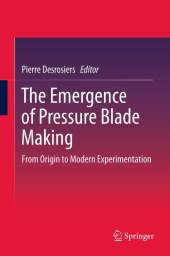 Neuerscheinungen 2014Stand: 2020-02-01 |
Schnellsuche
ISBN/Stichwort/Autor
|
Herderstraße 10
10625 Berlin
Tel.: 030 315 714 16
Fax 030 315 714 14
info@buchspektrum.de |

Pierre M. Desrosiers
The Emergence of Pressure Blade Making
From Origin to Modern Experimentation
Herausgegeben von Desrosiers, Pierre M.
2012. 2014. xii, 536 S. 184 SW-Abb.,. 235 mm
Verlag/Jahr: SPRINGER, BERLIN; SPRINGER NEW YORK; SPRINGER 2014
ISBN: 1-489-99110-7 (1489991107)
Neue ISBN: 978-1-489-99110-2 (9781489991102)
Preis und Lieferzeit: Bitte klicken
This seminal work on the Neolithic stone-working technique of pressure knapping combines research findings on this epoch-making skill from numerous cultures around the world-academic work that reflects the newly minted global thesis on the topic.
Human development is a long and steady process that began with stone tool making. Because of this skill, humans were able to adapt to climate changes, discover new territories, and invent new technologies. "Pressure knapping" is the common term for one method of creating stone tools, where a larger device or blade specifically made for this purpose is use to press out the stone tool. Pressure knapping was invented in different locations and at different points in time, representing the adoption of the Neolithic way of life in the Old world.
Recent research on pressure knapping has led for the first time to a global thesis on this technique. The contributors to this seminal work combine research findings on pressure knapping from different cultures around the globe to develope a cohesive theory. This contributions to this volume represents a significant development to research on pressure knapping, as well as the field of lithic studies in general.
This work will be an important reference for anyone studying the Paleolithic, Mesolithic, and Neolithic periods, lithic studies, technologies, and more generally, cultural transmission.
"This volume should be commended for its successful and holistic effort in highlighting phenomena associated with pressure blade production through experimental, archaeological and historical investigations. This almost Herculean effort is clear, concise and marks a milestone in studies of blade technology. It is quintessential for anyone interested in studies of pressure blade production." (Christian Steven Hoggard, Journal of Lithic Studies , Vol. 2, 2015)
"The Desrosiers volume leans more strongly towards the Continental tradition, and in typical c haîne opératoire fashion relies on empirical data to inform on lithic connaissances (knowledge) and savoir-faires (knowhow) to trace the culture historical progress of pressure blade flaking...Desrosiers provides an ideal opportunity to widen the investigative lens by considering technological approaches holistically." (Sarah Wurz, South African Archaeological Bulletin, Vol 199, 2014 )


